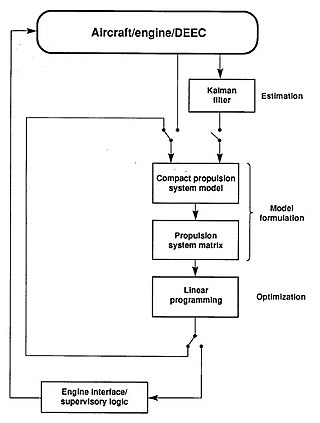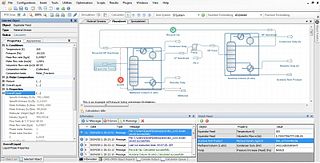Related Research Articles
Cost–benefit analysis (CBA), sometimes also called benefit–cost analysis, is a systematic approach to estimating the strengths and weaknesses of alternatives. It is used to determine options which provide the best approach to achieving benefits while preserving savings in, for example, transactions, activities, and functional business requirements. A CBA may be used to compare completed or potential courses of action, and to estimate or evaluate the value against the cost of a decision, project, or policy. It is commonly used to evaluate business or policy decisions, commercial transactions, and project investments. For example, the U.S. Securities and Exchange Commission must conduct cost-benefit analyses before instituting regulations or deregulations.
Process engineering is the understanding and application of the fundamental principles and laws of nature that allow humans to transform raw material and energy into products that are useful to society, at an industrial level. By taking advantage of the driving forces of nature such as pressure, temperature and concentration gradients, as well as the law of conservation of mass, process engineers can develop methods to synthesize and purify large quantities of desired chemical products. Process engineering focuses on the design, operation, control, optimization and intensification of chemical, physical, and biological processes. Process engineering encompasses a vast range of industries, such as agriculture, automotive, biotechnical, chemical, food, material development, mining, nuclear, petrochemical, pharmaceutical, and software development. The application of systematic computer-based methods to process engineering is "process systems engineering".
An industrial process control or simply process control in continuous production processes is a discipline that uses industrial control systems and control theory to achieve a production level of consistency, economy and safety which could not be achieved purely by human manual control. It is implemented widely in industries such as automotive, mining, dredging, oil refining, pulp and paper manufacturing, chemical processing and power generating plants.

A chemical plant is an industrial process plant that manufactures chemicals, usually on a large scale. The general objective of a chemical plant is to create new material wealth via the chemical or biological transformation and or separation of materials. Chemical plants use specialized equipment, units, and technology in the manufacturing process. Other kinds of plants, such as polymer, pharmaceutical, food, and some beverage production facilities, power plants, oil refineries or other refineries, natural gas processing and biochemical plants, water and wastewater treatment, and pollution control equipment use many technologies that have similarities to chemical plant technology such as fluid systems and chemical reactor systems. Some would consider an oil refinery or a pharmaceutical or polymer manufacturer to be effectively a chemical plant.
Reliability engineering is a sub-discipline of systems engineering that emphasizes the ability of equipment to function without failure. Reliability describes the ability of a system or component to function under stated conditions for a specified period. Reliability is closely related to availability, which is typically described as the ability of a component or system to function at a specified moment or interval of time.

A pilot plant is a pre-commercial production system that employs new production technology and/or produces small volumes of new technology-based products, mainly for the purpose of learning about the new technology. The knowledge obtained is then used for design of full-scale production systems and commercial products, as well as for identification of further research objectives and support of investment decisions. Other (non-technical) purposes include gaining public support for new technologies and questioning government regulations. Pilot plant is a relative term in the sense that pilot plants are typically smaller than full-scale production plants, but are built in a range of sizes. Also, as pilot plants are intended for learning, they typically are more flexible, possibly at the expense of economy. Some pilot plants are built in laboratories using stock lab equipment, while others require substantial engineering efforts, cost millions of dollars, and are custom-assembled and fabricated from process equipment, instrumentation and piping. They can also be used to train personnel for a full-scale plant. Pilot plants tend to be smaller compared to demonstration plants.
In chemical engineering, process design is the choice and sequencing of units for desired physical and/or chemical transformation of materials. Process design is central to chemical engineering, and it can be considered to be the summit of that field, bringing together all of the field's components.
A process flow diagram (PFD) is a diagram commonly used in chemical and process engineering to indicate the general flow of plant processes and equipment. The PFD displays the relationship between major equipment of a plant facility and does not show minor details such as piping details and designations. Another commonly used term for a PFD is processflowsheet. It is the key document in process design.
A cost estimate is the approximation of the cost of a program, project, or operation. The cost estimate is the product of the cost estimating process. The cost estimate has a single total value and may have identifiable component values.
Engineering economics, previously known as engineering economy, is a subset of economics concerned with the use and "...application of economic principles" in the analysis of engineering decisions. As a discipline, it is focused on the branch of economics known as microeconomics in that it studies the behavior of individuals and firms in making decisions regarding the allocation of limited resources. Thus, it focuses on the decision making process, its context and environment. It is pragmatic by nature, integrating economic theory with engineering practice. But, it is also a simplified application of microeconomic theory in that it assumes elements such as price determination, competition and demand/supply to be fixed inputs from other sources. As a discipline though, it is closely related to others such as statistics, mathematics and cost accounting. It draws upon the logical framework of economics but adds to that the analytical power of mathematics and statistics.

The technology life cycle (TLC) describes the commercial gain of a product through the expense of research and development phase, and the financial return during its "vital life". Some technologies, such as steel, paper or cement manufacturing, have a long lifespan while in other cases, such as electronic or pharmaceutical products, the lifespan may be quite short.
Process flowsheeting is the use of computer aids to perform steady-state heat and mass balancing, sizing and costing calculations for a chemical process. It is an essential and core component of process design.

A control-flow diagram (CFD) is a diagram to describe the control flow of a business process, process or review.

Process simulation is used for the design, development, analysis, and optimization of technical process of simulation of processes such as: chemical plant s, chemical processes, environmental systems, power stations, complex manufacturing operations, biological processes, and similar technical functions.
Energy Management Software (EMS) is a general term and category referring to a variety of energy-related software applications which may provide utility bill tracking, real-time metering, building HVAC and lighting control systems, building simulation and modeling, carbon and sustainability reporting, IT equipment management, demand response, and/or energy audits. Managing energy can require a system of systems approach.
Front-End Engineering (FEE), or Front-End Engineering Design (FEED), is an engineering design approach used to control project expenses and thoroughly plan a project before a fix bid quote is submitted. It may also be referred to as Pre-project planning (PPP), front-end loading (FEL), feasibility analysis, or early project planning.
Quantemol Ltd is based in University College London initiated by Professor Jonathan Tennyson FRS and Dr. Daniel Brown in 2004. The company initially developed a unique software tool, Quantemol-N, which provides full accessibility to the highly sophisticated UK molecular R-matrix codes, used to model electron polyatomic molecule interactions. Since then Quantemol has widened to further types of simulation, with plasmas and industrial plasma tools, in Quantemol-VT in 2013 and launched in 2016 a sustainable database Quantemol-DB, representing the chemical and radiative transport properties of a wide range of plasmas.
Analytica is a visual software developed by Lumina Decision Systems for creating, analyzing and communicating quantitative decision models. It combines hierarchical influence diagrams for visual creation and view of models, intelligent arrays for working with multidimensional data, Monte Carlo simulation for analyzing risk and uncertainty, and optimization, including linear and nonlinear programming. Its design is based on ideas from the field of decision analysis. As a computer language, it combines a declarative (non-procedural) structure for referential transparency, array abstraction, and automatic dependency maintenance for efficient sequencing of computation.
In the petroleum industry, allocation refers to practices of breaking down measures of quantities of extracted hydrocarbons across various contributing sources. Allocation aids the attribution of ownerships of hydrocarbons as each contributing element to a commingled flow or to a storage of petroleum may have a unique ownership. Contributing sources in this context are typically producing petroleum wells delivering flows of petroleum or flows of natural gas to a commingled flow or storage.
Sensitivity analysis identifies how uncertainties in input parameters affect important measures of building performance, such as cost, indoor thermal comfort, or CO2 emissions. Input parameters for buildings fall into roughly three categories:
References
- 1 2 Chai, Slyvester Yew Wang; Phang, Frederick Jit Fook; Yeo, Lip Siang; Ngu, Lock Hei; How, Bing Shen (2022). "Future era of techno-economic analysis: Insights from review". Frontiers in Sustainability. 3. doi: 10.3389/frsus.2022.924047 . ISSN 2673-4524.
- ↑ Perry, Robert H.; Green, Don W. (2008). Perry's chemical engineers' handbook (8th ed.). New York: McGraw-Hill. pp. 9–10. ISBN 978-0-07-159313-7. OCLC 194071107.
- 1 2 AACE International (2005). Cost Estimate Classification System – As Applied In Engineering, Procurement, And Construction For The Process Industries; TCM Framework: 7.3 – Cost Estimating and Budgeting. Page 2.
- 1 2 3 Peters, Max S. (2003). Plant design and economics for chemical engineers. Klaus D. Timmerhaus, Ronald E. West (5th ed.). New York: McGraw-Hill. p. 273. ISBN 0-07-239266-5. OCLC 50410278.
- ↑ Cortes-Peña, Yoel; Kumar, Deepak; Singh, Vijay; Guest, Jeremy S. (2020-03-02). "BioSTEAM: A Fast and Flexible Platform for the Design, Simulation, and Techno-Economic Analysis of Biorefineries under Uncertainty". ACS Sustainable Chemistry & Engineering. 8 (8): 3302–3310. doi: 10.1021/acssuschemeng.9b07040 . ISSN 2168-0485.
- ↑ Huntington, Tyler; Baral, Nawa Raj; Yang, Minliang; Sundstrom, Eric; Scown, Corinne D. (1 February 2023). "Machine learning for surrogate process models of bioproduction pathways" (PDF). Bioresource Technology. 370: 128528. Bibcode:2023BiTec.37028528H. doi: 10.1016/j.biortech.2022.128528 . PMID 36574885. S2CID 255120419.
- ↑ Peng, Peng; Anastasopoulou, Aikaterini; Brooks, Kriston; Furukawa, Hiroyasu; Bowden, Mark; Long, Jeffrey; Autrey, Thomas; Breunig, Hanna (25 April 2022). "Cost and potential of metal–organic frameworks for hydrogen back-up power supply" (PDF). Nature Energy. 7 (5): 448–458. Bibcode:2022NatEn...7..448P. doi:10.1038/s41560-022-01013-w. S2CID 256708350.
- ↑ Peng, Peng; Yang, Lin; Menon, Akansha; Weger, Nathaniel; Prasher, Ravi; Prasher, Breunig; Hanna, Lubner; Sean (16 January 2022). "Techno-economic Analysis of High-Temperature Thermal Energy Storage for On-Demand Heat and Power". ChemRxiv. doi:10.26434/chemrxiv-2022-3l03r. S2CID 246032753.
- ↑ Zimmermann, Arno W.; Wunderlich, Johannes; Müller, Leonard; Buchner, Georg A.; Marxen, Annika; Michailos, Stavros; Armstrong, Katy; Naims, Henriette; McCord, Stephen; Styring, Peter; Sick, Volker (2020). "Techno-Economic Assessment Guidelines for CO2 Utilization" (PDF). Frontiers in Energy Research. 8. doi: 10.3389/fenrg.2020.00005 . ISSN 2296-598X.
- ↑ Scown, Corinne D; Baral, Nawa Raj; Yang, Minliang; Vora, Nemi; Huntington, Tyler (1 February 2021). "Technoeconomic analysis for biofuels and bioproducts" (PDF). Current Opinion in Biotechnology. 67: 58–64. doi: 10.1016/j.copbio.2021.01.002 . PMID 33477090. S2CID 231679223.